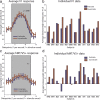Stimulus predictability reduces responses in primary visual cortex
- PMID: 20181593
- PMCID: PMC6633950
- DOI: 10.1523/JNEUROSCI.3730-10.2010
Stimulus predictability reduces responses in primary visual cortex
Abstract
In this functional magnetic resonance imaging study we tested whether the predictability of stimuli affects responses in primary visual cortex (V1). The results of this study indicate that visual stimuli evoke smaller responses in V1 when their onset or motion direction can be predicted from the dynamics of surrounding illusory motion. We conclude from this finding that the human brain anticipates forthcoming sensory input that allows predictable visual stimuli to be processed with less neural activation at early stages of cortical processing.
Figures



Comment in
-
Predictive coding and the neural response to predictable stimuli.J Neurosci. 2010 Jun 30;30(26):8702-3. doi: 10.1523/JNEUROSCI.2248-10.2010. J Neurosci. 2010. PMID: 20592191 Free PMC article. No abstract available.
References
-
- Angelucci A, Bressloff PC. Contribution of feedforward, lateral and feedback connections to the classical receptive field center and extra-classical receptive field surround of primate V1 neurons. Prog Brain Res. 2006;154:93–120. - PubMed
-
- Angelucci A, Bullier J. Reaching beyond the classical receptive field of V1 neurons: horizontal or feedback axons? J Physiol Paris. 2003;97:141–154. - PubMed
-
- Bar M. The proactive brain: using analogies and associations to generate predictions. Trends Cogn Sci. 2007;11:280–289. - PubMed
